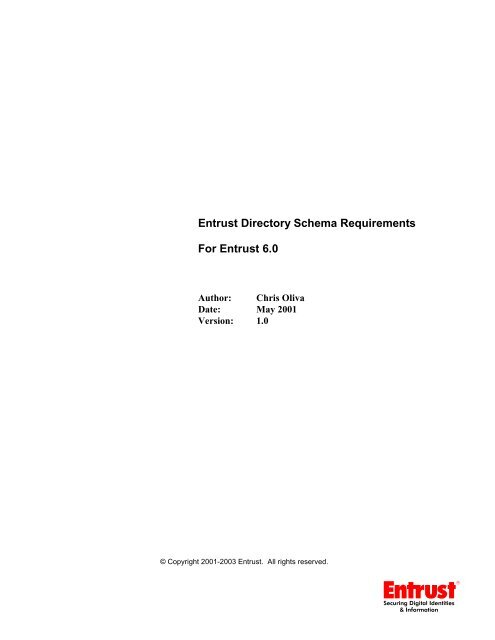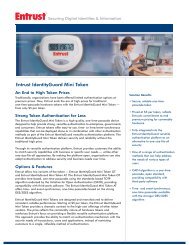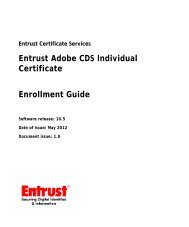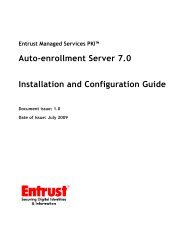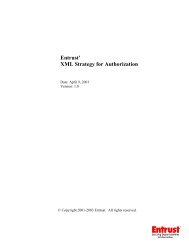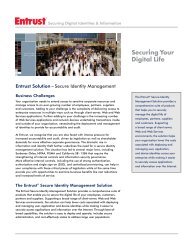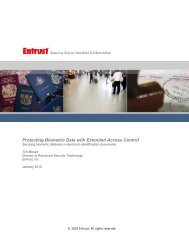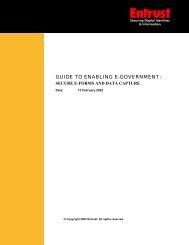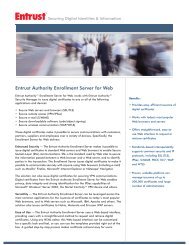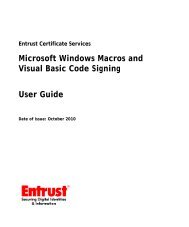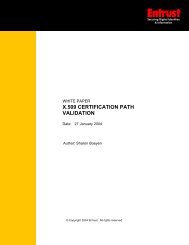Entrust Directory Schema Requirements for Entrust 6.0
Entrust Directory Schema Requirements for Entrust 6.0
Entrust Directory Schema Requirements for Entrust 6.0
Create successful ePaper yourself
Turn your PDF publications into a flip-book with our unique Google optimized e-Paper software.
<strong>Entrust</strong> <strong>Directory</strong> <strong>Schema</strong> <strong>Requirements</strong><br />
For <strong>Entrust</strong> <strong>6.0</strong><br />
Author: Chris Oliva<br />
Date: May 2001<br />
Version: 1.0<br />
© Copyright 2001-2003 <strong>Entrust</strong>. All rights reserved.
<strong>Entrust</strong> is a registered trademark of <strong>Entrust</strong>, Inc. in the United States and certain other<br />
countries. <strong>Entrust</strong> is a registered trademark of <strong>Entrust</strong> Limited in Canada. All other <strong>Entrust</strong><br />
product names and service names are trademarks or registered trademarks of <strong>Entrust</strong>, Inc<br />
or <strong>Entrust</strong> Limited. All other company and product names are trademarks or registered<br />
trademarks of their respective owners.<br />
© Copyright 2001-2003 <strong>Entrust</strong>. All rights reserved.<br />
ii
Revision History<br />
Date Comments Version<br />
May 2001 First Version 1.0<br />
iii
Table of Contents<br />
1. INTRODUCTION ............................................................................................................................... 1<br />
2. SCHEMA SUMMARY....................................................................................................................... 1<br />
3. OBJECT CLASSES ............................................................................................................................ 4<br />
3.1 ENTRUSTPOLICYOBJECT OBJECT CLASS............................................................................................ 4<br />
3.2 ENTRUSTCA OBJECT CLASS.............................................................................................................. 4<br />
3.3 ENTRUSTUSER OBJECT CLASS........................................................................................................... 5<br />
3.4 RFC 822MAILUSER OBJECT CLASS.................................................................................................... 5<br />
3.5 EMAILADDRESSUSER OBJECT CLASS ................................................................................................ 6<br />
3.6 UNIQUELYIDENTIFIEDUSER OBJECT CLASS ....................................................................................... 6<br />
3.7 SIMPLEAUTHOBJECT OBJECT CLASS ................................................................................................. 7<br />
3.8 ENTRUSTNAMEDOBJECT OBJECT CLASS ........................................................................................... 7<br />
3.9 UNIQUELYQUALIFIEDOBJECT OBJECT CLASS .................................................................................... 7<br />
3.10 ENTRUSTROAMINGUSER OBJECT CLASS....................................................................................... 8<br />
3.11 MSMAILUSER OBJECT CLASS ....................................................................................................... 8<br />
3.12 CCMAILUSER OBJECT CLASS ....................................................................................................... 9<br />
3.13 QMMAILUSER OBJECT CLASS....................................................................................................... 9<br />
3.14 TRUSTTYPES OBJECT CLASS......................................................................................................... 9<br />
3.15 PKCS10DEVICE OBJECT CLASS ................................................................................................. 10<br />
3.16 CEPDEVICE OBJECT CLASS ........................................................................................................ 10<br />
3.17 ENTRUSTDNQUALIFIERUSER OBJECT CLASS ............................................................................. 10<br />
4. ATTRIBUTES ................................................................................................................................... 11<br />
4.1 ENTRUSTPOLICYCERTIFICATE ATTRIBUTE....................................................................................... 11<br />
4.2 ATTRIBUTECERTIFICATE ATTRIBUTE ............................................................................................... 11<br />
4.3 ENTRUSTROAMFILEENCINFO ATTRIBUTE ....................................................................................... 12<br />
4.4 ENTRUSTROAMINGEOP ATTRIBUTE................................................................................................ 12<br />
4.5 ENTRUSTROAMINGPAB ATTRIBUTE ............................................................................................... 13<br />
4.6 ENTRUSTROAMINGPROFILE ATTRIBUTE .......................................................................................... 13<br />
4.7 ENTRUSTROAMINGPRV ATTRIBUTE ............................................................................................... 13<br />
4.8 ENTRUSTROAMINGRECIPLIST ATTRIBUTE....................................................................................... 14<br />
4.9 ENTRUSTROAMINGSLA ATTRIBUTE................................................................................................ 14<br />
4.10 ENTRUSTROAMINGCAPAB ATTRIBUTE ..................................................................................... 14<br />
4.11 MSMAILPOSTOFFICE ATTRIBUTE ................................................................................................ 15<br />
4.12 MSMAILNETWORK ATTRIBUTE................................................................................................... 15<br />
4.13 MSMAILID ATTRIBUTE............................................................................................................... 15<br />
4.14 MSMAILFULLNAME ATTRIBUTE.................................................................................................. 16<br />
4.15 CCMAILPOSTOFFICE ATTRIBUTE................................................................................................. 16<br />
4.16 CCMAILNAME ATTRIBUTE.......................................................................................................... 16<br />
4.17 CCMAILCOMMENTS ATTRIBUTE................................................................................................. 17<br />
4.18 QMZONE ATTRIBUTE .................................................................................................................. 17<br />
4.19 QMMAILCENTER ATTRIBUTE...................................................................................................... 17<br />
4.20 QMUSERNAME ATTRIBUTE......................................................................................................... 18<br />
4.21 SMIMETRUST ATTRIBUTE ........................................................................................................... 18<br />
4.22 SSLTRUST ATTRIBUTE ................................................................................................................ 18<br />
4.23 OBJSIGNTRUST ATTRIBUTE ........................................................................................................ 19<br />
5. NAME FORMS ................................................................................................................................. 19<br />
iv
5.1 UNIQUE PERSON NAME FORM......................................................................................................... 19<br />
5.2 UNIQUE ORGANIZATIONAL PERSON NAME FORM............................................................................ 19<br />
5.3 UNIQUE RESIDENTIAL PERSON NAME FORM ................................................................................... 20<br />
5.4 EMAIL USER ORGANIZATIONAL PERSON NAME FORM .................................................................... 20<br />
5.5 VPN DEVICE NAME FORM.............................................................................................................. 20<br />
5.6 ENTRUST CEP DEVICE NAME FORM............................................................................................... 21<br />
5.7 ENTRUST PKCS 10 DEVICE ............................................................................................................ 21<br />
6. STRUCTURE AND CONTENT RULES ........................................................................................ 21<br />
7. SCHEMA ISSUES............................................................................................................................. 23<br />
7.1 ATTRIBUTE CERTIFICATE................................................................................................................. 23<br />
v
<strong>Entrust</strong> <strong>Directory</strong> <strong>Schema</strong> <strong>Requirements</strong> <strong>for</strong> <strong>Entrust</strong> <strong>6.0</strong><br />
1. Introduction<br />
This document describes the schema required <strong>for</strong> directory interoperability with<br />
<strong>Entrust</strong>/PKI 1 and <strong>Entrust</strong>-Ready products. More detailed descriptions of directory<br />
requirements and directory integration issues are available in associated white papers<br />
from <strong>Entrust</strong> (including interoperability with Microsoft ® Active <strong>Directory</strong>).<br />
Products that use this schema specification must support the indicated object classes and<br />
attributes. Name Forms are defined which indicate how entries might be named. Products<br />
should support functionality, which will allow the equivalent implementation of the<br />
recommended Name Forms (users of <strong>Entrust</strong>/PKI are free to implement any Name Forms<br />
regardless of the definitions contained within this document).<br />
2. <strong>Schema</strong> Summary<br />
This section provides a table reference, which lists all the object classes and attributes<br />
used by the <strong>Entrust</strong> software. The table groups the schema elements according to specific<br />
product solutions. For example, The “MSMail Components” are only required by the<br />
integrated MS Mail solution however “Core <strong>Schema</strong> Components” are required by all<br />
<strong>Entrust</strong> solutions including the <strong>Entrust</strong>/PKI product.<br />
The tables represent the minimum schema configuration required <strong>for</strong> <strong>Entrust</strong> and does not<br />
preclude the use of additional schema elements. Standard schema definitions are not<br />
included within this document but are referenced. The “LDAP Name” column specifies<br />
alternate names required <strong>for</strong> LDAP servers (the LDAP Name is only specified if it differs<br />
from the attribute name in the first column). The “Requirement” column is used to<br />
describe whether the schema item is mandatory or optional. There are three possible<br />
categories <strong>for</strong> the “Requirement” field:<br />
Mandatory<br />
The <strong>Entrust</strong> software requires this item.<br />
Default<br />
The default configuration of the <strong>Entrust</strong> software requires this item.<br />
Optional<br />
The item is not directly used by the <strong>Entrust</strong> software. The item is included as a<br />
convenience <strong>for</strong> the implementation of the directory schema.<br />
Items introduced after version 4.0 of <strong>Entrust</strong> are indicated in the "Version" column with<br />
the associated <strong>Entrust</strong> version number <strong>for</strong> which they are required. These items are also<br />
required in subsequent versions of <strong>Entrust</strong> software unless otherwise noted.<br />
1 This document describes schema requirements <strong>for</strong> <strong>Entrust</strong>/PKI 4.x, 5.x and <strong>6.0</strong>.<br />
1
<strong>Entrust</strong> <strong>Directory</strong> <strong>Schema</strong> <strong>Requirements</strong> <strong>for</strong> <strong>Entrust</strong> <strong>6.0</strong><br />
Object Classes<br />
Object Class Defined In Requirement Version<br />
Core <strong>Schema</strong> Components<br />
cRLDistributionPoint X.521 / RFC 2256 Mandatory<br />
organizationalRole X.521 / RFC 2256 Mandatory 5<br />
<strong>Entrust</strong>PolicyObject <strong>Entrust</strong> <strong>Schema</strong> Document Default 5<br />
pkiCA X.509 (2000) / RFC 2587 Default 5<br />
entrustCA <strong>Entrust</strong> <strong>Schema</strong> Document Default<br />
pkiUser X.509 (2000) / RFC 2587 Default 5<br />
pmiUser X.509 (2000) Default 5.1<br />
entrustUser <strong>Entrust</strong> <strong>Schema</strong> Document Default<br />
person X.521 / RFC 2256 Default<br />
organizationalPerson X.521 / RFC 2256 Default<br />
rfc822MailUser <strong>Entrust</strong> <strong>Schema</strong> Document Default<br />
emailAddressUser <strong>Entrust</strong> <strong>Schema</strong> Document Default<br />
organizationalUnit X.521 / RFC 2256 Default<br />
applicationProcess X.521 / RFC 2256 Default 5<br />
uniquelyIdentifiedUser <strong>Entrust</strong> <strong>Schema</strong> Document Default<br />
simpleAuthObject <strong>Entrust</strong> <strong>Schema</strong> Document Optional<br />
entrustNamedObject <strong>Entrust</strong> <strong>Schema</strong> Document Optional 5<br />
entrustDnQualifierUser <strong>Entrust</strong> <strong>Schema</strong> Document Optional 5<br />
uniquelyQualifiedObject <strong>Entrust</strong> <strong>Schema</strong> Document Optional 5<br />
<strong>Entrust</strong>/Roaming Solution<br />
entrustRoamingUser <strong>Entrust</strong> <strong>Schema</strong> Document Mandatory 5<br />
MS Mail Components<br />
msMailUser <strong>Entrust</strong> <strong>Schema</strong> Document Mandatory<br />
Lotus cc:Mail Components<br />
ccMailUser <strong>Entrust</strong> <strong>Schema</strong> Document Mandatory<br />
Quick Mail Components<br />
qmMailUser <strong>Entrust</strong> <strong>Schema</strong> Document Mandatory<br />
<strong>Entrust</strong>-Ready Netscape Components<br />
trustTypes <strong>Entrust</strong> <strong>Schema</strong> Document Mandatory<br />
<strong>Entrust</strong>/VPNConnector Components<br />
pKCS10Device <strong>Entrust</strong> <strong>Schema</strong> Document Mandatory<br />
cEPDevice <strong>Entrust</strong> <strong>Schema</strong> Document Mandatory<br />
2
<strong>Entrust</strong> <strong>Directory</strong> <strong>Schema</strong> <strong>Requirements</strong> <strong>for</strong> <strong>Entrust</strong> <strong>6.0</strong><br />
Attributes<br />
Attribute Type LDAP Name Defined In Requirement New Item<br />
Core <strong>Schema</strong> Components (common to all products)<br />
userCertificate (v3) X.509 (1997) / RFC 2256 Mandatory<br />
cACertificate X.509 (1997) / RFC 2256 Mandatory<br />
certificateRevocationList (v2) X.509 (1997) / RFC 2256 Mandatory<br />
authorityRevocationList X.509 (1997) / RFC 2256 Mandatory<br />
crossCertificatePair X.509 (1997) / RFC 2256 Mandatory<br />
entrustPolicyCertificate <strong>Entrust</strong> <strong>Schema</strong> Document Mandatory 5<br />
commonName cn X.520 / RFC 2256 Mandatory<br />
objectClass X.501 / RFC 2256 Mandatory<br />
userPassword X.509 (1997) / RFC 2256 Optional<br />
attributeCertificateAttribute X.509 Default 2 5.1<br />
attributeCertificate <strong>Entrust</strong> <strong>Schema</strong> Document Mandatory 3<br />
surname sn X.520 / RFC 2256 Default<br />
serialNumber X.520 / RFC 2256 Default<br />
rfc822Mailbox mail RFC 1274 Default 4<br />
emailAddress email PKCS #9 Default<br />
countryName c X.520 / RFC 2256 Default<br />
organizationName o X.520 / RFC 2256 Default<br />
organizationalUnitName ou X.520 / RFC 2256 Default<br />
description X.520 / RFC 2256 Default 5<br />
<strong>Entrust</strong>/Roaming Solution<br />
entrustRoamFileEncInfo <strong>Entrust</strong> <strong>Schema</strong> Document Mandatory 5<br />
entrustRoamingEOP <strong>Entrust</strong> <strong>Schema</strong> Document Mandatory 5<br />
entrustRoamingPAB <strong>Entrust</strong> <strong>Schema</strong> Document Mandatory 5<br />
entrustRoamingProfile <strong>Entrust</strong> <strong>Schema</strong> Document Mandatory 5<br />
entrustRoamingPRV <strong>Entrust</strong> <strong>Schema</strong> Document Mandatory 5<br />
entrustRoamingRecipList <strong>Entrust</strong> <strong>Schema</strong> Document Mandatory 5<br />
entrustRoamingSLA <strong>Entrust</strong> <strong>Schema</strong> Document Mandatory 5<br />
entrustRoamingCAPAB <strong>Entrust</strong> <strong>Schema</strong> Document Mandatory 5<br />
userID uid RFC 1274 Default 5<br />
MS Mail Components<br />
msMailPostoffice <strong>Entrust</strong> <strong>Schema</strong> Document Mandatory<br />
msMailNetwork <strong>Entrust</strong> <strong>Schema</strong> Document Mandatory<br />
msMailId <strong>Entrust</strong> <strong>Schema</strong> Document Mandatory 5<br />
msMailFullName <strong>Entrust</strong> <strong>Schema</strong> Document Mandatory<br />
CC Mail Components<br />
ccMailPostoffice <strong>Entrust</strong> <strong>Schema</strong> Document Mandatory<br />
ccMailName <strong>Entrust</strong> <strong>Schema</strong> Document Mandatory<br />
ccMailComments <strong>Entrust</strong> <strong>Schema</strong> Document Mandatory<br />
Quick Mail Components<br />
2 The attributeCertificateAttribute attribute is used <strong>for</strong> the Attribute Authority feature new to <strong>Entrust</strong> 5.1.<br />
<strong>Entrust</strong>/PKI 5.1 must be configured to use this attribute name. See section 7.1 <strong>for</strong> more in<strong>for</strong>mation.<br />
3 The attributeCertificate attribute is Mandatory <strong>for</strong> backwards compatibility with <strong>Entrust</strong> 4.x or earlier<br />
products.<br />
4 The rfc822Mailbox attribute is Mandatory <strong>for</strong> <strong>Entrust</strong>/Express <strong>for</strong> Lotus ® Notes.<br />
5 msMailId is also optionally required <strong>for</strong> <strong>Entrust</strong>/Express <strong>for</strong> Microsoft ® Outlook and Microsoft Exchange.<br />
3
<strong>Entrust</strong> <strong>Directory</strong> <strong>Schema</strong> <strong>Requirements</strong> <strong>for</strong> <strong>Entrust</strong> <strong>6.0</strong><br />
qmZone <strong>Entrust</strong> <strong>Schema</strong> Document Mandatory<br />
qmMailCenter <strong>Entrust</strong> <strong>Schema</strong> Document Mandatory<br />
qmUserName <strong>Entrust</strong> <strong>Schema</strong> Document Mandatory<br />
<strong>Entrust</strong>-Ready Netscape Components<br />
smimetrust <strong>Entrust</strong> <strong>Schema</strong> Document Mandatory<br />
ssltrust <strong>Entrust</strong> <strong>Schema</strong> Document Mandatory<br />
objsigntrust <strong>Entrust</strong> <strong>Schema</strong> Document Mandatory<br />
<strong>Entrust</strong>/VPNConnector Components<br />
unstructuredName PKCS #9 Mandatory<br />
unstructuredAddress PKCS #9 Mandatory<br />
3. Object Classes<br />
The specifications <strong>for</strong> <strong>Entrust</strong>-defined object classes are included below, expressed in the<br />
same ASN.1 notation as the object classes defined in X.521.<br />
3.1 entrustPolicyObject Object Class<br />
The entrustPolicyObject object class is used to extend the schema <strong>for</strong> objects which contain<br />
policy in<strong>for</strong>mation. The affected objects in the directory include the CA, which acts as the<br />
policy distribution point, and the policy objects created beneath the CA (one policy object<br />
is created <strong>for</strong> each Role defined in the PKI; these entries are created with the<br />
organizationalRole structural object class).<br />
entrustPolicyObject OBJECT-CLASS ::= {<br />
SUBCLASS OF {top}<br />
KIND<br />
auxiliary<br />
MAY CONTAIN { entrustPolicyCertificate}<br />
ID<br />
id-nsn-oc-entrustPolicyObject}<br />
The OID <strong>for</strong> id-nsn-oc-entrustPolicyObject is 1 2 840 113533 7 67 17<br />
3.2 entrustCA Object Class<br />
The entrustCA auxiliary object class is used to configure directory entries representing<br />
<strong>Entrust</strong>/Authority Certification Authorities. Alternatively, the pkiCA auxiliary object<br />
class may be used instead of entrustCA as long as the attributeCertificate attribute is not<br />
required <strong>for</strong> backwards compatibility with <strong>Entrust</strong> 4.x or earlier products.<br />
4
<strong>Entrust</strong> <strong>Directory</strong> <strong>Schema</strong> <strong>Requirements</strong> <strong>for</strong> <strong>Entrust</strong> <strong>6.0</strong><br />
The entrustCA or pkiCA object classes are only required to allow their associated attributes<br />
to be added to the indicated entries. If the directory product supports other mechanisms<br />
<strong>for</strong> controlling schema content then the use of these object classes is not mandatory. If<br />
their use is needed then one or both of entrustCA and pkiCA must be added to the CA entry<br />
be<strong>for</strong>e <strong>Entrust</strong>/PKI initialization.<br />
The specification of this object class is:<br />
entrustCA OBJECT-CLASS ::= {<br />
SUBCLASS OF { top }<br />
KIND<br />
auxiliary<br />
MAY CONTAIN { cACertificate |<br />
certificationRevocationList |<br />
authorityRevocationList |<br />
crossCertificatePair |<br />
userPassword |<br />
attributeCertificate }<br />
ID id-nsn-oc-entrustCA }<br />
The OID <strong>for</strong> id-nsn-oc-entrustCA is 1 2 840 113533 7 67 1<br />
3.3 entrustUser Object Class<br />
The entrustUser object class is used to identify directory entries which are managed<br />
by<strong>Entrust</strong>/Authority. This value will be added to the objectClass attribute when the object<br />
represented by that entry is first issued a certificate by <strong>Entrust</strong>/Authority. The value will<br />
be present <strong>for</strong> the entire time that the object has credentials managed by<br />
<strong>Entrust</strong>/Authority.<br />
The specification of this object class is:<br />
entrustUser OBJECT-CLASS ::= {<br />
SUBCLASS OF { top }<br />
KIND<br />
auxiliary<br />
MAY CONTAIN { userCertificate }<br />
ID id-nsn-oc-entrustUser }<br />
The OID <strong>for</strong> id-nsn-oc-entrustUser is 1 2 840 113533 7 67 0<br />
3.4 rfc 822MailUser Object Class<br />
The rfc822MailUser object class is used to allow the rfc822Mailbox attribute to be added to an<br />
entry.<br />
The specification of this object class is:<br />
5
<strong>Entrust</strong> <strong>Directory</strong> <strong>Schema</strong> <strong>Requirements</strong> <strong>for</strong> <strong>Entrust</strong> <strong>6.0</strong><br />
rfc822MailUser OBJECT-CLASS ::= {<br />
SUBCLASS OF { top }<br />
KIND<br />
auxiliary<br />
MAY CONTAIN { rfc822Mailbox } – from RFC 1274 - refers to LDAP “mail” attribute<br />
ID id-nsn-oc-rfc822MailUser }<br />
The OID <strong>for</strong> id-nsn-oc-rfc822MailUser is 1 2 840 113533 7 67 7<br />
3.5 emailAddressUser Object Class<br />
The emailAddressUser object class is used to the PKCS9 emailAddress attribute to be added<br />
to an entry.<br />
The specification of this object class is:<br />
emailAddressUser OBJECT-CLASS ::= {<br />
SUBCLASS OF { top }<br />
KIND<br />
auxiliary<br />
MAY CONTAIN { emailAddress } – from PKCS #9 - refers to LDAP “email” attribute<br />
ID id-nsn-oc-emailAddressUser }<br />
The OID <strong>for</strong> id-nsn-oc-emailAddressUser is 1 2 840 113533 7 67 9<br />
3.6 uniquelyIdentifiedUser Object Class<br />
The uniquelyIdentifiedUser object class is used to specify that an entry must contain a<br />
serialNumber attribute. This attribute will be used to uniquely identify the object<br />
represented by that entry. One of the values of the serialNumber attribute should be<br />
distinguished, and that value must be unique within the <strong>Directory</strong> Management Domain<br />
(DMD) responsible <strong>for</strong> the entry.<br />
The specification of this object class is:<br />
uniquelyIdentifiedUser OBJECT-CLASS ::= {<br />
AUXILIARY<br />
SUBCLASS OF { top }<br />
MUST CONTAIN { serialNumber }<br />
ID id-nsn-oc-uniquelyIdentifiedUser }<br />
The OID <strong>for</strong> id-nsn-oc-uniquelyIdentifiedUser is 1 2 840 113533 7 67 4<br />
6
<strong>Entrust</strong> <strong>Directory</strong> <strong>Schema</strong> <strong>Requirements</strong> <strong>for</strong> <strong>Entrust</strong> <strong>6.0</strong><br />
3.7 simpleAuthObject Object Class<br />
The simpleAuthObject object class is used to allow an entry to contain a userPassword<br />
attribute. This object class is not used by <strong>Entrust</strong> software and is only provided <strong>for</strong> user<br />
convenience.<br />
The specification of this object class is:<br />
simpleAuthObject OBJECT-CLASS ::= {<br />
SUBCLASS OF { top }<br />
KIND<br />
auxiliary<br />
MUST CONTAIN { userPassword }<br />
ID id-nsn-oc-simpleAuthObject }<br />
The OID <strong>for</strong> id-nsn-oc-simpleAuthObject is 1 2 840 113533 7 67 5<br />
3.8 entrustNamedObject Object Class<br />
The entrustNamedObject object class is used to allow a series of useful attributes<br />
commonly used <strong>for</strong> naming to be included in an entry. This object class is not used by<br />
<strong>Entrust</strong> software but is provided <strong>for</strong> convenience.<br />
entrustNamedObject OBJECT-CLASS ::= {<br />
SUBCLASS OF {top}<br />
KIND<br />
auxiliary<br />
MAY CONTAIN { name |<br />
commonName |<br />
surname |<br />
givenName |<br />
initials |<br />
generationQualifier |<br />
countryName |<br />
localityName |<br />
stateOrProvinceName |<br />
organizationName |<br />
organizationalUnitName |<br />
title |<br />
domainComponent | -- from RFC 1274 – refers to LDAP “dc” attribute<br />
dmdName }<br />
ID id-nsn-oc-entrustNamedObject }<br />
The OID <strong>for</strong> id-nsn-oc-entrustNamedObject is 1 2 840 113533 7 67 15<br />
3.9 uniquelyQualifiedObject Object Class<br />
The uniquelyQualifiedObject object class is provided <strong>for</strong> convenience to allow users to<br />
include attributes in entries which can be used to uniquely qualify an object.<br />
7
<strong>Entrust</strong> <strong>Directory</strong> <strong>Schema</strong> <strong>Requirements</strong> <strong>for</strong> <strong>Entrust</strong> <strong>6.0</strong><br />
uniquelyQualifiedObject OBJECT-CLASS ::= {<br />
SUBCLASS OF {top}<br />
KIND<br />
auxiliary<br />
MAY CONTAIN { serialNumber |<br />
dnQualifier |<br />
userId | -- from RFC 1274 - refers to LDAP “uid” attribute<br />
rfc822Mailbox | -- from RFC 1274 - refers to LDAP “mail” attribute<br />
description}<br />
ID id-nsn-oc-uniquelyQualifiedObject }<br />
The OID <strong>for</strong> id-nsn-oc-uniquelyQualifiedObject is 1 2 840 113533 7 67 16<br />
3.10 entrustRoamingUser Object Class<br />
This object class is used to identify a user as being a roaming user.<br />
entrustRoamingUser OBJECT-CLASS ::= {<br />
SUBCLASS OF {top}<br />
KIND<br />
auxiliary<br />
MAY CONTAIN {entrustRoamFileEncInfo |<br />
entrustRoamingProfile |<br />
entrustRoamingPAB |<br />
entrustRoamingRecipList |<br />
entrustRoamingSLA |<br />
entrustRoamingPRV |<br />
entrustRoamingEOP |<br />
entrustRoamingCAPAB|<br />
userId – from RFC 1274 – refers to LDAP “uid” attribute }<br />
ID id-nsn-oc-entrustRoamingUser }<br />
The OID <strong>for</strong> id-nsn-oc-entrustRoamingUser is 1 2 840 113533 7 67 13<br />
3.11 msMailUser Object Class<br />
The msMailUser object class is <strong>for</strong> use in directory content rules and <strong>for</strong> use in denoting<br />
that an entry represents a MSMail user.<br />
The specification of this object class is:<br />
msMailUser OBJECT-CLASS ::= {<br />
SUBCLASS OF { top }<br />
KIND<br />
auxiliary<br />
MAY CONTAIN { msMailFullname |<br />
msMailId |<br />
msMailNetwork |<br />
msMailPostoffice }<br />
ID id-nsn-oc-msMailUser }<br />
8
<strong>Entrust</strong> <strong>Directory</strong> <strong>Schema</strong> <strong>Requirements</strong> <strong>for</strong> <strong>Entrust</strong> <strong>6.0</strong><br />
The OID <strong>for</strong> id-nsn-oc-msMailUser is 1 2 840 113533 7 67 3<br />
3.12 ccMailUser Object Class<br />
The ccMailUser object class is <strong>for</strong> use in directory content rules and <strong>for</strong> use in denoting that<br />
an entry represents a cc:mail user.<br />
The specification of this object class is:<br />
ccMailUser OBJECT-CLASS ::= {<br />
SUBCLASS OF { top }<br />
KIND<br />
auxiliary<br />
MAY CONTAIN { ccMailComments |<br />
ccMailName |<br />
ccMailPostoffice }<br />
ID id-nsn-oc-ccMailUser }<br />
The OID <strong>for</strong> id-nsn-oc-ccMailUser is 1 2 840 113533 7 67 2<br />
3.13 qmMailUser Object Class<br />
The qmMailUser object class is used in content rules and in denoting that an entry<br />
represents a QuickMail user.<br />
The specification of this object class is:<br />
qmMailUser OBJECT-CLASS ::= {<br />
SUBCLASS OF { top }<br />
KIND<br />
auxiliary<br />
MAY CONTAIN { qmUserName |<br />
qmMailCenter |<br />
qmZone }<br />
ID id-nsn-oc-qmMailUser }<br />
The OID <strong>for</strong> id-nsn-oc-qmMailUser is 1 2 840 113533 7 67 6<br />
3.14 trustTypes Object Class<br />
The trustTypes object class is used in content rules and in denoting that an entry represents<br />
an <strong>Entrust</strong>-Ready Netscape user with specific trust types.<br />
The specification of this object class is:<br />
trustTypes OBJECT-CLASS ::= {<br />
SUBCLASS OF { top }<br />
KIND<br />
auxiliary<br />
MAY CONTAIN {smimetrust |<br />
9
<strong>Entrust</strong> <strong>Directory</strong> <strong>Schema</strong> <strong>Requirements</strong> <strong>for</strong> <strong>Entrust</strong> <strong>6.0</strong><br />
ssltrust |<br />
objsigntrust }<br />
ID id-nsn-oc-trustTypes }<br />
The OID <strong>for</strong> id-nsn-oc-trustTypes is 1 2 840 113533 7 67 8<br />
3.15 pKCS10Device Object Class<br />
The pKCS10Device object class is used by the <strong>Entrust</strong>/VPNConnector to search <strong>for</strong><br />
PKCS#10 enabled devices in the directory.<br />
The specification of this object class is:<br />
pKCS10Device OBJECT-CLASS ::= {<br />
SUBCLASS OF { top }<br />
KIND<br />
auxiliary<br />
MAY CONTAIN { serialNumber }<br />
ID id-nsn-oc-pKCS10Device }<br />
The OID <strong>for</strong> pKCS10Device is 1 2 840 113533 7 67 12<br />
3.16 cEPDevice Object Class<br />
The cEPDevice object class is used, by the <strong>Entrust</strong>/VPNConnector to search <strong>for</strong> Cisco ®<br />
Enrollment Protocol devices in the directory.<br />
The specification of this object class is:<br />
cEPDevice OBJECT-CLASS ::= {<br />
SUBCLASS OF { top }<br />
KIND<br />
auxiliary<br />
MAY CONTAIN { unstructuredName |<br />
unstructuredAddress }<br />
ID id-nsn-oc-cEPDevice }<br />
The OID <strong>for</strong> cEPDevice is 1 2 840 113533 7 67 11<br />
3.17 entrustDNQualifierUser Object Class<br />
The entrustDNQualifierUser object class is not used by <strong>Entrust</strong> software; it is provided <strong>for</strong><br />
convenience so that the dnQualifier attribute can be added to an entry.<br />
The specification of this object class is:<br />
10
<strong>Entrust</strong> <strong>Directory</strong> <strong>Schema</strong> <strong>Requirements</strong> <strong>for</strong> <strong>Entrust</strong> <strong>6.0</strong><br />
entrustDNQualifierUser OBJECT-CLASS ::= {<br />
SUBCLASS OF { top }<br />
KIND<br />
auxiliary<br />
MAY CONTAIN dnQualifier<br />
ID id-nsn-oc-entrustDNQualifierUser }<br />
The OID <strong>for</strong> entrustDNQualifierUser is 1 2 840 113533 7 67 14<br />
4. Attributes<br />
The specification of each attribute is included below, expressed in the same ASN.1<br />
<strong>for</strong>mat as the attributes defined in X.520. Where new attribute syntaxes are also required,<br />
their specification is included with the attribute specification. For attributes defined<br />
elsewhere, a reference is included to the authoritative source <strong>for</strong> that syntax specification.<br />
4.1 entrustPolicyCertificate Attribute<br />
The entrustPolicyCertificate attribute is included to replace the attributeCertificate attribute <strong>for</strong><br />
<strong>Entrust</strong> v5.0 products. It contains policy in<strong>for</strong>mation and is contained within role specific<br />
policy entries.<br />
The syntax of this attribute is an <strong>Entrust</strong> specific opaque DER encoded CA-signed syntax.<br />
For schema configuration purposes, the syntax is defined in a generic manner:<br />
entrustPolicyCertificate ATTRIBUTE ::= {<br />
WITH SYNTAX<br />
OCTET STRING<br />
ID id-nsn-at-entrustPolicyCertificate }<br />
The OID <strong>for</strong> id-nsn-at-entrustPolicyCertificate is 1 2 840 113533 7 68 30<br />
4.2 attributeCertificate Attribute<br />
Note that the attribute definition in this section defines an early version of the attribute<br />
certificate used by early versions of <strong>Entrust</strong>. This attribute is superseded by the standard<br />
definition. For more discussion on this attribute and which definition should be used,<br />
please see section 7.1.<br />
The specification of this attribute is:<br />
attributeCertificate ATTRIBUTE ::= {<br />
WITH SYNTAX<br />
AttributeCertificate<br />
ID id-nsn-at-attributeCertificate }<br />
11
<strong>Entrust</strong> <strong>Directory</strong> <strong>Schema</strong> <strong>Requirements</strong> <strong>for</strong> <strong>Entrust</strong> <strong>6.0</strong><br />
AttributeCertificate ::= SIGNED {AttributeCertificateInfo}<br />
AttributeCertificateInfo ::= SEQUENCE {<br />
owner CHOICE {<br />
baseCertificateID [0] IssuerSerial,<br />
entityName [1] Name } -- set to CA Name<br />
issuer Name, -- issuer name<br />
Number CertificateSerialNumber,<br />
validity Validity,<br />
attributes SEQUENCE OF Attribute,<br />
issuerUniqueID UniqueIdentifier OPTIONAL }<br />
The OID <strong>for</strong> attributeCertificate is 1 2 840 113533 7 68 10<br />
4.3 entrustRoamFileEncInfo Attribute<br />
This attribute is used to specify in<strong>for</strong>mation about the key used to encrypt the roaming<br />
user's profile. This attribute must support unbounded maximum sizes. Substring and<br />
ordering matching rules are not required.<br />
Current sizing estimates place this attribute size between 800bytes and 2Kbytes.<br />
entrustRoamFileEncInfo ATTRIBUTE ::= {<br />
WITH SYNTAX<br />
OCTET STRING<br />
EQUALITY MATCHING RULE octetStringMatch<br />
ID id-nsn-at-entrustRoamFileEncInfo }<br />
The OID <strong>for</strong> id-nsn-at-entrustRoamFileEncInfo is 1 2 840 113533 7 68 22<br />
4.4 entrustRoamingEOP Attribute<br />
This attribute is used to store a user's <strong>Entrust</strong> Options File (EOP file) encrypted with a<br />
symmetric key. This attribute must support unbounded maximum sizes. Substring and<br />
ordering matching rules are not required.<br />
Current sizing estimates place this attribute size between 2 Kbytes and 8 Kbytes.<br />
entrustRoamingEOP ATTRIBUTE ::= {<br />
WITH SYNTAX<br />
OCTET STRING<br />
EQUALITY MATCHING RULE octetStringMatch<br />
ID id-nsn-at-entrustRoamingEOP }<br />
The OID <strong>for</strong> id-nsn-at-entrustRoamingEOP is 1 2 840 113533 7 68 28<br />
12
<strong>Entrust</strong> <strong>Directory</strong> <strong>Schema</strong> <strong>Requirements</strong> <strong>for</strong> <strong>Entrust</strong> <strong>6.0</strong><br />
4.5 entrustRoamingPAB Attribute<br />
This attribute is used to store a user's Personal Address Book encrypted with a symmetric<br />
key. This attribute must support unbounded maximum sizes. Substring and ordering<br />
matching rules are not required.<br />
Current sizing estimates place this attribute size at 5 Kbytes per Personal Address Book<br />
entry <strong>for</strong> a given user.<br />
entrustRoamingPAB ATTRIBUTE ::= {<br />
WITH SYNTAX<br />
OCTET STRING<br />
EQUALITY MATCHING RULE octetStringMatch<br />
ID id-nsn-at-entrustRoamingPAB }<br />
The OID <strong>for</strong> id-nsn-at-entrustRoamingPAB is 1 2 840 113533 7 68 24<br />
4.6 entrustRoamingProfile Attribute<br />
This attribute is used to store a user's <strong>Entrust</strong> Profile (EPF) encrypted with a symmetric<br />
key. This attribute must support unbounded maximum sizes. Substring and ordering<br />
matching rules are not required.<br />
Current sizing estimates place this attribute size at 9 Kbytes. This attribute is expected to<br />
grow by approximately 2 Kbytes each time a user's keys roll over.<br />
entrustRoamingProfile ATTRIBUTE ::= {<br />
WITH SYNTAX<br />
OCTET STRING<br />
EQUALITY MATCHING RULE octetStringMatch<br />
ID id-nsn-at-entrustRoamingProfile }<br />
The OID <strong>for</strong> id-nsn-at-entrustRoamingProfile is 1 2 840 113533 7 68 23<br />
4.7 entrustRoamingPRV Attribute<br />
This attribute is used to store a user's PRV file encrypted with a symmetric key. This<br />
attribute must support unbounded maximum sizes. Substring and ordering matching rules<br />
are not required.<br />
Current sizing estimates place this attribute size at approximately 3 Kbytes per Common<br />
Key group <strong>for</strong> which the user is a member.<br />
entrustRoamingPRV ATTRIBUTE ::= {<br />
WITH SYNTAX<br />
OCTET STRING<br />
EQUALITY MATCHING RULE octetStringMatch<br />
ID id-nsn-at-entrustRoamingPRV }<br />
13
<strong>Entrust</strong> <strong>Directory</strong> <strong>Schema</strong> <strong>Requirements</strong> <strong>for</strong> <strong>Entrust</strong> <strong>6.0</strong><br />
The OID <strong>for</strong> id-nsn-at-entrustRoamingPRV is 1 2 840 113533 7 68 27<br />
4.8 entrustRoamingRecipList Attribute<br />
This attribute is used to store a user's recipient lists (user’s ERL file) encrypted with a<br />
symmetric key. This attribute must support unbounded maximum sizes. Substring and<br />
ordering matching rules are not required.<br />
Current sizing estimates place this attribute size at 5 Kbytes per entry in a Recipient List<br />
<strong>for</strong> a given user.<br />
<strong>Entrust</strong>RoamingRecipList ATTRIBUTE ::= {<br />
WITH SYNTAX<br />
OCTET STRING<br />
EQUALITY MATCHING RULE octetStringMatch<br />
ID id-nsn-at-entrustRoamingRecipList }<br />
The OID <strong>for</strong> id-nsn-at-entrustRoamingRecipList is 1 2 840 113533 7 68 25<br />
4.9 entrustRoamingSLA Attribute<br />
This attribute is used to store a user's Single Login Application list (SLA file) encrypted<br />
with a symmetric key. This attribute must support unbounded maximum sizes. Substring<br />
and ordering matching rules are not required.<br />
Current sizing estimates place this attribute size at 4 Kbytes per <strong>Entrust</strong>-Ready<br />
application <strong>for</strong> a given user.<br />
entrustRoamingSLA ATTRIBUTE ::= {<br />
WITH SYNTAX<br />
OCTET STRING<br />
EQUALITY MATCHING RULE octetStringMatch<br />
ID id-nsn-at-entrustRoamingSLA }<br />
The OID <strong>for</strong> id-nsn-at-entrustRoamingSLA is 1 2 840 113533 7 68 26<br />
4.10 entrustRoamingCAPAB Attribute<br />
This attribute is used to store a user’s CA PAB encrypted with a symmetric key. This<br />
attribute must support unbounded maximum sizes. Substring and ordering matching rules<br />
are not required.<br />
Current sizing estimates place this attribute size at 3 Kbytes per CA certificate imported<br />
into a given user's CA PAB.<br />
entrustRoamingCAPAB ATTRIBUTE ::= {<br />
WITH SYNTAX<br />
OCTET STRING<br />
14
<strong>Entrust</strong> <strong>Directory</strong> <strong>Schema</strong> <strong>Requirements</strong> <strong>for</strong> <strong>Entrust</strong> <strong>6.0</strong><br />
EQUALITY MATCHING RULE octetStringMatch<br />
ID id-nsn-at-entrustRoamingCAPAB }<br />
The OID <strong>for</strong> id-nsn-at-entrustRoamingCAPAB is 1 2 840 113533 7 79 0<br />
4.11 msMailPostoffice Attribute<br />
The msMailPostoffice attribute is used to store an MS Mail user’s postoffice in<strong>for</strong>mation in<br />
their <strong>Directory</strong> entry.<br />
The specification of this attribute is:<br />
msMailPostoffice ATTRIBUTE ::= {<br />
WITH SYNTAX <strong>Directory</strong>String { 256 }<br />
EQUALITY MATCHING RULE caseIgnoreMatch<br />
SUBSTRINGS MATCHING RULE caseIgnoreSubstringsMatch<br />
ID id-nsn-at-msMailPostoffice }<br />
The OID <strong>for</strong> id-nsn-at-msMailPostoffice is 1 2 840 113533 7 68 9<br />
4.12 msMailNetwork Attribute<br />
The msMailNetwork attribute is used to store an MS Mail user’s network in<strong>for</strong>mation in<br />
their <strong>Directory</strong> entry.<br />
The specification of this attribute is:<br />
msMailNetwork ATTRIBUTE ::= {<br />
WITH SYNTAX <strong>Directory</strong>String { 256 }<br />
EQUALITY MATCHING RULE caseIgnoreMatch<br />
SUBSTRINGS MATCHING RULE caseIgnoreSubstringsMatch<br />
ID id-nsn-at-msMailNetwork }<br />
The OID <strong>for</strong> id-nsn-at-msMailNetwork is 1 2 840 113533 7 68 8<br />
4.13 msMailID Attribute<br />
The msMailId attribute is used to store an MS Mail user’s identifier in their <strong>Directory</strong><br />
entry.<br />
The specification of this attribute is:<br />
msMailId ATTRIBUTE ::= {<br />
WITH SYNTAX <strong>Directory</strong>String { 256 }<br />
EQUALITY MATCHING RULE caseIgnoreMatch<br />
SUBSTRINGS MATCHING RULE caseIgnoreSubstringsMatch<br />
ID id-nsn-at-msMailId }<br />
15
<strong>Entrust</strong> <strong>Directory</strong> <strong>Schema</strong> <strong>Requirements</strong> <strong>for</strong> <strong>Entrust</strong> <strong>6.0</strong><br />
The OID <strong>for</strong> id-nsn-at-msMailId is 1 2 840 113533 7 68 7<br />
4.14 msMailFullname Attribute<br />
The msMailFullname attribute is used to store an MS Mail user’s fullname in their<br />
<strong>Directory</strong> entry.<br />
The specification of this attribute is:<br />
msMailFullname ATTRIBUTE ::= {<br />
WITH SYNTAX <strong>Directory</strong>String { 256 }<br />
EQUALITY MATCHING RULE caseIgnoreMatch<br />
SUBSTRINGS MATCHING RULE caseIgnoreSubstringsMatch<br />
ID id-nsn-at-msMailFullname }<br />
The OID <strong>for</strong> id-nsn-at-msMailFullname is 1 2 840 113533 7 68 6<br />
4.15 ccMailPostoffice Attribute<br />
The ccMailPostoffice attribute is used to store the ccMail postoffice <strong>for</strong> a user in their<br />
<strong>Directory</strong> entry.<br />
The specification of this attribute is:<br />
ccMailPostoffice ATTRIBUTE ::= {<br />
WITH SYNTAX <strong>Directory</strong>String { 256 }<br />
EQUALITY MATCHING RULE caseIgnoreMatch<br />
SUBSTRINGS MATCHING RULE caseIgnoreSubstringsMatch<br />
ID id-nsn-at-ccMailPostoffice }<br />
The OID <strong>for</strong> id-nsn-at-ccMailPostoffice is 1 2 840 113533 7 68 3<br />
4.16 ccMailName Attribute<br />
The ccMailName attribute is used to store the ccMail name of a user in their <strong>Directory</strong><br />
entry.<br />
The specification of this attribute is:<br />
ccMailName ATTRIBUTE ::= {<br />
WITH SYNTAX <strong>Directory</strong>String { 256 }<br />
EQUALITY MATCHING RULE caseIgnoreMatch<br />
SUBSTRINGS MATCHING RULE caseIgnoreSubstringsMatch<br />
ID id-nsn-at-ccMailName }<br />
The OID <strong>for</strong> id-nsn-at-ccMailName is 1 2 840 113533 7 68 2<br />
16
<strong>Entrust</strong> <strong>Directory</strong> <strong>Schema</strong> <strong>Requirements</strong> <strong>for</strong> <strong>Entrust</strong> <strong>6.0</strong><br />
4.17 ccMailComments Attribute<br />
The ccMailComments attribute is used to store additional in<strong>for</strong>mation about a ccMail user<br />
in their <strong>Directory</strong> entry.<br />
The specification of this attribute is:<br />
ccMailComments ATTRIBUTE ::= {<br />
WITH SYNTAX <strong>Directory</strong>String { 256 }<br />
EQUALITY MATCHING RULE caseIgnoreMatch<br />
SUBSTRINGS MATCHING RULE caseIgnoreSubstringsMatch<br />
ID id-nsn-at-ccMailComments }<br />
The OID <strong>for</strong> id-nsn-at-ccMailComments is 1 2 840 113533 7 68 4<br />
4.18 qmZone Attribute<br />
The qmZone attribute is used to store a QuickMail user’s mail zone in<strong>for</strong>mation in their<br />
<strong>Directory</strong> entry.<br />
The specification of this attribute is:<br />
qmZone ATTRIBUTE ::= {<br />
WITH SYNTAX <strong>Directory</strong>String { 32 }<br />
EQUALITY MATCHING RULE caseIgnoreMatch<br />
SUBSTRINGS MATCHING RULE caseIgnoreSubstringsMatch<br />
ID id-nsn-at-qmZone }<br />
The OID <strong>for</strong> id-nsn-at-qmZone is 1 2 840 113533 7 68 14<br />
4.19 qmMailCenter Attribute<br />
The qmMailCenter attribute is used to store a QuickMail user’s mail center in<strong>for</strong>mation in<br />
their <strong>Directory</strong> entry.<br />
The specification of this attribute is:<br />
qmMailCenter ATTRIBUTE ::= {<br />
WITH SYNTAX <strong>Directory</strong>String { 13 }<br />
EQUALITY MATCHING RULE caseIgnoreMatch<br />
SUBSTRINGS MATCHING RULE caseIgnoreSubstringsMatch<br />
ID id-nsn-at-qmMailCenter }<br />
The OID <strong>for</strong> id-nsn-at-qmMailCenter is 1 2 840 113533 7 68 13<br />
17
<strong>Entrust</strong> <strong>Directory</strong> <strong>Schema</strong> <strong>Requirements</strong> <strong>for</strong> <strong>Entrust</strong> <strong>6.0</strong><br />
4.20 qmUserName Attribute<br />
The qmUserName attribute is used to store a QuickMail user’s name in their <strong>Directory</strong><br />
entry.<br />
The specification of this attribute is:<br />
qmUserName ATTRIBUTE ::= {<br />
WITH SYNTAX <strong>Directory</strong>String { 31 }<br />
EQUALITY MATCHING RULE caseIgnoreMatch<br />
SUBSTRINGS MATCHING RULE caseIgnoreSubstringsMatch<br />
ID id-nsn-at-qmUserName }<br />
The OID <strong>for</strong> id-nsn-at-qmUserName is 1 2 840 113533 7 68 12<br />
4.21 smimeTrust Attribute<br />
The smimetrust attribute is used to represent the state of trust assigned <strong>for</strong> S/MIME<br />
(internal, internal+PAB or external). The attribute is stored in the user's entry. Matching<br />
rules should be configured which allow matching <strong>for</strong> presence and equality.<br />
The specification of this attribute is:<br />
smimetrust ATTRIBUTE ::= {<br />
WITH SYNTAX<br />
IA5String<br />
ID id-nsn-at-smimetrust }<br />
The OID <strong>for</strong> id-nsn-at-smimetrust is 1 2 840 113533 7 68 17<br />
4.22 sslTrust Attribute<br />
The ssltrust attribute is used to represent the state of trust assigned <strong>for</strong> SSL (internal,<br />
internal+PAB or external). The attribute is stored in the user's entry. Matching rules<br />
should be configured which allow matching <strong>for</strong> presence and equality.<br />
The specification of this attribute is:<br />
ssltrust ATTRIBUTE ::= {<br />
WITH SYNTAX<br />
IA5String<br />
ID id-nsn-at-ssltrust }<br />
The OID <strong>for</strong> id-nsn-at-ssltrust is 1 2 840 113533 7 68 18<br />
18
<strong>Entrust</strong> <strong>Directory</strong> <strong>Schema</strong> <strong>Requirements</strong> <strong>for</strong> <strong>Entrust</strong> <strong>6.0</strong><br />
4.23 objSignTrust Attribute<br />
The objsigntrust attribute is used to represent the state of trust assigned <strong>for</strong> object signing<br />
(internal, internal+PAB or external). The attribute is stored in the user's entry. Matching<br />
rules should be configured which allow matching <strong>for</strong> presence and equality.<br />
The specification of this attribute is:<br />
objsigntrust ATTRIBUTE ::= {<br />
WITH SYNTAX<br />
IA5String<br />
ID id-nsn-at-objsigntrust }<br />
The OID <strong>for</strong> id-nsn-at-objsigntrust is 1 2 840 113533 7 68 19<br />
5. Name Forms<br />
The specification of each name <strong>for</strong>m is included below, expressed in the same ASN.1<br />
<strong>for</strong>mat as the name <strong>for</strong>ms defined in X.521.<br />
5.1 Unique Person Name Form<br />
The uniquePersonNameForm name <strong>for</strong>m is used to name entries of the person object class.<br />
This name <strong>for</strong>m is recommended by <strong>Entrust</strong> but is not required.<br />
The specification of this name <strong>for</strong>m is:<br />
uniquePersonNameForm NAME-FORM<br />
NAMES<br />
person<br />
WITH ATTRIBUTES { commonName | serialNumber }<br />
ID id-nsn-nf-uniquePersonNameForm }<br />
The OID <strong>for</strong> id-nsn-nf-uniquePersonNameForm is 1 2 840 113533 7 69 1<br />
5.2 Unique Organizational Person Name Form<br />
The uniqueOrganizationalPersonNameForm name <strong>for</strong>m is used to name entries of the<br />
organizationalPerson object class. This name <strong>for</strong>m is recommended by <strong>Entrust</strong> but is not<br />
required.<br />
The specification of this name <strong>for</strong>m is:<br />
uniqueOrganizationalPersonNameForm NAME-FORM<br />
NAMES<br />
OrganizationalPerson<br />
WITH ATTRIBUTES { commonName | serialNumber }<br />
AND OPTIONALLY { organizationalUnitName }<br />
ID id-nsn-nf-uniqueOrganizationalPersonNameForm }<br />
19
<strong>Entrust</strong> <strong>Directory</strong> <strong>Schema</strong> <strong>Requirements</strong> <strong>for</strong> <strong>Entrust</strong> <strong>6.0</strong><br />
The OID <strong>for</strong> id-nsn-nf-uniqueOrganizationalPersonNameForm is 1 2 840 113533 7 69 2<br />
5.3 Unique Residential Person Name Form<br />
The uniqueResidentialPersonNameForm name <strong>for</strong>m is used to name entries of the<br />
residentialPerson object class. This name <strong>for</strong>m is recommended by <strong>Entrust</strong> but is not<br />
required.<br />
The specification of this name <strong>for</strong>m is:<br />
uniqueResidentialPersonNameForm NAME-FORM<br />
NAMES<br />
ResidentialPerson<br />
WITH ATTRIBUTES { commonName | serialNumber }<br />
AND OPTIONALLY { streetAddress }<br />
ID id-nsn-nf-uniqueResidentialPersonNameForm }<br />
The OID <strong>for</strong> id-nsn-nf-uniqueResidentialPersonNameForm is 1 2 840 113533 7 69 3<br />
5.4 Email User Organizational Person Name Form<br />
The emailUserOrgPersonNameForm name <strong>for</strong>m is used to name entries of the<br />
organizationalPerson object class. This name <strong>for</strong>m is included <strong>for</strong> backwards compatibility<br />
with S/MIME v2.<br />
The specification of this name <strong>for</strong>m is:<br />
emailUserOrgPersonNameForm NAME-FORM<br />
NAMES<br />
OrganizationalPerson<br />
WITH ATTRIBUTES { commonName }<br />
AND OPTIONALLY { organizationalUnitName | serialNumber | emailAddress }<br />
ID id-nsn-nf- emailUserOrgPersonNameForm }<br />
The OID <strong>for</strong> id-nsn-nf-emailUserOrgPersonNameForm is 1 2 840 113533 7 69 4<br />
5.5 VPN Device Name Form<br />
The deviceVPN name <strong>for</strong>m is used to name entries of the device object class.<br />
The specification of this name <strong>for</strong>m is:<br />
deviceVPNNameForm NAME-FORM<br />
NAMES<br />
device<br />
WITH ATTRIBUTES { commonName }<br />
AND OPTIONALLY { serialNumber |<br />
UnstructuredAddress |<br />
UnstructuredName }<br />
20
<strong>Entrust</strong> <strong>Directory</strong> <strong>Schema</strong> <strong>Requirements</strong> <strong>for</strong> <strong>Entrust</strong> <strong>6.0</strong><br />
ID id-nsn-nf-deviceVPNNameForm }<br />
The OID <strong>for</strong> id-nsn-nf-deviceVPNNameForm is 1 2 840 113533 7 69 5<br />
5.6 <strong>Entrust</strong> CEP Device Name Form<br />
This name <strong>for</strong>m is required <strong>for</strong> interoperability with Cisco routers that<br />
require device entries to be named with the unstructuredName, serialNumber and<br />
the unstructuredAddress attributes.<br />
The definition of the name <strong>for</strong>m is:<br />
<strong>Entrust</strong>CEPDeviceNameForm NAME-FORM ::= {<br />
NAMES<br />
device<br />
WITH ATTRIBUTES { UnstructuredName }<br />
AND OPTIONALLY { UnstructuredAddress |<br />
serialNumber }<br />
ID <strong>Entrust</strong>-NameForm-<strong>Entrust</strong>CEPDeviceNameForm }<br />
The OID <strong>for</strong> <strong>Entrust</strong>CEPDeviceNameForm is 2 16 840 1 114027 20 1<br />
5.7 <strong>Entrust</strong> PKCS 10 Device<br />
This name <strong>for</strong>m is required <strong>for</strong> interoperability with Cisco routers that require<br />
device entries to be named with commonName, serialNumber and description attributes.<br />
The definition of the name <strong>for</strong>m is:<br />
<strong>Entrust</strong>PKCS10DeviceNameForm NAME-FORM ::= {<br />
NAMES<br />
device<br />
WITH ATTRIBUTES { commonName }<br />
AND OPTIONALLY { serialNumber |<br />
description }<br />
ID <strong>Entrust</strong>-NameForm-<strong>Entrust</strong>PKCS10DeviceNameForm }<br />
The OID <strong>for</strong> <strong>Entrust</strong>PKCS10DeviceNameForm is 2 16 840 1 114027 20 2<br />
6. Structure and Content Rules<br />
The structure and content rules required <strong>for</strong> <strong>Entrust</strong> are explained below. Specific content<br />
required be<strong>for</strong>e <strong>Entrust</strong>/PKI initialization is detailed:<br />
1. The structural object class of the CA entry is not mandated however most<br />
organizations will use either the organization or organizationalUnit structural object<br />
class. The directory schema must allow the CA entry to contain the following<br />
21
<strong>Entrust</strong> <strong>Directory</strong> <strong>Schema</strong> <strong>Requirements</strong> <strong>for</strong> <strong>Entrust</strong> <strong>6.0</strong><br />
attributes: caCertificate, certificateRevocationList, crossCertificatePair, and<br />
authorityRevocationList. The pkiCA object class can optionally be used to extend<br />
the schema of the CA entry <strong>for</strong> this purpose.<br />
The CA entry must be added be<strong>for</strong>e initializing the <strong>Entrust</strong>/PKI. If required, the<br />
pkiCA object class must also be added to the entry.<br />
2. For backwards compatibility with <strong>Entrust</strong> 4.x or earlier products, the CA entry must<br />
also contain the attributeCertificate attribute. In this configuration, the entrustCA<br />
object class can optionally be used to extend the schema of the CA entry.<br />
If required, the entrustCA object class must be added to the CA entry be<strong>for</strong>e<br />
initializing the <strong>Entrust</strong>/PKI.<br />
3. The CA will bind to the directory using the DN of its directory entry as the bind DN.<br />
The CA will per<strong>for</strong>m simple authentication there<strong>for</strong>e the CA must have a password<br />
and write/modify access configured in the directory. Many products associate the<br />
authentication password with the userPassword attribute. In this case, the CA entry<br />
must contain the userPassword attribute. The simpleAuthObject object class can<br />
optionally be used to extend the schema of the CA entry <strong>for</strong> this purpose.<br />
The CA entry must be configured with appropriate bind credentials and access control<br />
privileges be<strong>for</strong>e installing the <strong>Entrust</strong>/PKI.<br />
4. <strong>Entrust</strong> RA (and other administrative products) will use the credentials of the<br />
<strong>Directory</strong> Administrator to bind to the directory using simple authentication. This will<br />
allow administrators to create and modify directory entries which represent <strong>Entrust</strong><br />
user end-entities. This requires the directory to be configured with a DN and password<br />
<strong>for</strong> the <strong>Directory</strong> Administrator. It is not necessary <strong>for</strong> the <strong>Directory</strong> Administrator to<br />
be represented by an entry in the directory.<br />
The <strong>Directory</strong> Administrator must be configured with appropriate bind credentials<br />
and access control privileges be<strong>for</strong>e installing the <strong>Entrust</strong>/PKI.<br />
5. The CA entry will act as the policy distribution point <strong>for</strong> the PKI. This requires the<br />
CA entry to contain the entrustPolicyCertificate attribute. The entrustPolicyObject<br />
object class will be used to extend the schema of the CA entry <strong>for</strong> this purpose.<br />
6. The DIT structure rules must allow entries of structural object class<br />
cRLDistributionPoint, organizationalPerson and organizationalRole to be created<br />
beneath the CA entry.<br />
7. Policy objects will be created beneath the CA entry with a structural object class of<br />
organizationalRole. These entries must be able to contain the<br />
entrustPolicyCertificate attribute and entrustPolicyObject object class.<br />
22
<strong>Entrust</strong> <strong>Directory</strong> <strong>Schema</strong> <strong>Requirements</strong> <strong>for</strong> <strong>Entrust</strong> <strong>6.0</strong><br />
8. <strong>Entrust</strong> defines the concept of a Search Base in order to identify name spaces within<br />
the DIT. The Search Base is defined as a non-leaf node within the DIT. The structural<br />
object class of the Search Base is not mandated however the default configuration of<br />
<strong>Entrust</strong>/RA will allow organizationalUnit entries to be created <strong>for</strong> this purpose.<br />
The default configuration of <strong>Entrust</strong>/PKI uses the CA entry as the initial Search Base.<br />
9. The DIT structure rules must allow end user entries to be created beneath Search Base<br />
entries. If Person entries are created with <strong>Entrust</strong>/RA then the default structural object<br />
class of end user entries will be organizationalPerson. If Web Server entries are<br />
created with <strong>Entrust</strong>/RA, the default structural object class is applicationProcess.<br />
The default configuration <strong>for</strong> <strong>Entrust</strong>/RA can be changed to accommodate any entry<br />
type that may be required.<br />
10. <strong>Entrust</strong>/RA will use the commonName attribute to name entries. For Person entries,<br />
the default configuration will allow the serialNumber attribute to be added as part of<br />
the entry name (i.e. as a distinguished value). The default configuration can be<br />
changed to accommodate any naming requirements that may be necessary.<br />
11. The CA will issue certificates to end-users. The public key encryption certificate will<br />
be added by the CA to end-user entries in the userCertificate attribute. The default<br />
configuration of the CA will add the entrustUser and pkiUser object classes to end<br />
user entries.<br />
12. The CA will (optionally) issue Attribute Certificates to end-users. This will be added<br />
to the entry in the attributeCertificateAttribute attribute. The default configuration<br />
of the CA will add the pmiUser object class to the end user entry.<br />
13. The <strong>Entrust</strong>/VPNConnector product requires that end entity directory entries be<br />
created with the device structural object class. The DIT structure rules must require<br />
these entries to be created under the CA entry as well as the Search Base entries. The<br />
directory must allow these end entities to contain the pKCS10Device and cEPDevice<br />
auxiliary object classes as well as the serialNumber, unstructuredName and<br />
unstructuredAddress attributes.<br />
7. <strong>Schema</strong> Issues<br />
This section discusses schema implementation issues.<br />
7.1 Attribute Certificate<br />
Early versions of <strong>Entrust</strong> (be<strong>for</strong>e 5.0) used an attribute called “attributeCertificate” to<br />
store policy in<strong>for</strong>mation. This attribute is only used in the directory entry of the<br />
Certification Authority. The auxiliary object class that allows this attribute to be added to<br />
any entry is the entrustCA object class.<br />
23
<strong>Entrust</strong> <strong>Directory</strong> <strong>Schema</strong> <strong>Requirements</strong> <strong>for</strong> <strong>Entrust</strong> <strong>6.0</strong><br />
As of <strong>Entrust</strong> 5.0, policy in<strong>for</strong>mation is published to a new attribute defined as<br />
“entrustPolicyCertificate”. For backwards compatibility with old clients (be<strong>for</strong>e release<br />
5.0) the attributeCertificate is still required; if backwards compatiblity with the old clients<br />
is not required, then the attributeCertificate is not needed.<br />
The X.509 standard defines an attribute called “attributeCertificateAttribute”. This<br />
attribute is used to publish attribute in<strong>for</strong>mation about a user and especially <strong>for</strong> an<br />
Attribute Authority to assign privileges. The auxiliary object class that allows this<br />
attribute to be added to any entry is the pmiUser object class. At the time of publication<br />
of this document, these schema items are defined in X.509 as well as the current working<br />
internet draft:<br />
http://www.ietf.org/internet-drafts/draft-ietf-pkix-ldap-schema-01.txt<br />
<strong>Entrust</strong>/PKI 5.1 has the ability to use issue Attribute Certificates but must be configured<br />
to use the “attributeCertificateAttribute” attribute. <strong>Entrust</strong>/PKI <strong>6.0</strong> will use the<br />
“attributeCertificateAttribute” by default requiring no extra configuration..<br />
24


